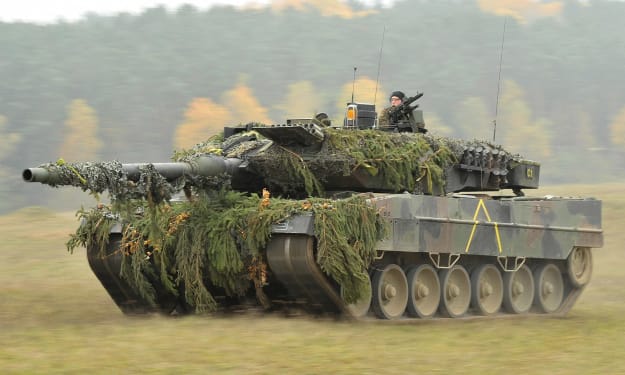Could One Weapon Change Geopolitics?
The power balance is delicate in the Taiwan Strait - could one missile tip the balance?

A new Chinese weapon has just been uncovered at the 2022 Zhuhai Air Show.
Two missiles marked “2PZD-21” were seen mounted on pylons beneath the wings of an Xian H-6K strategic bomber that landed at Jinwan airport in Zhuhai, the southern coastal city where the biennial Air Show China was being held.
‘Experts’ say that the shape of the missile’s warhead is similar to the Russian Kh-47 Kinzhal.

The Kh-47M2 Kinzhal, NATO reporting name Killjoy, is a Russian nuclear-capable hypersonic aero-ballistic air-to-surface missile. It has a claimed range of more than 2,000 km, Mach 12 speed, and an ability to perform evasive maneuvers at every stage of its flight. — Wikipedia
But before we go any further, note the bio of that Twitter source:

So it’s definitely a message from the government of the People’s Republic of China.
Its display at the air show could be seen as a warning to the United States and its commitment to the defence of Taiwan in the event of an attempted Chinese invasion.
Why is the missile so dangerous?
All signs point to it being similar to the Kinzhal, and here’s what Wikipedia says about the Kinzhal:
The missile is designed to hit NATO warships posing a threat to strategic missile systems in European Russia and to destroy NATO missile defence systems, ballistic missile defense ships and land objects close to the Russian borders. It is allegedly designed to overcome any known or planned NATO air or missile defense systems including the MIM-104 Patriot, Terminal High Altitude Area Defense and Aegis Combat System.
Note the term NATO warships.
That implies accuracy derived from a precision guidance system.
So, the Chinese 2PZD-21 could be a real carrier-buster.
The Dong-Feng 21 (DF-21, ‘East Wind’) is China’s current carrier-buster, but it is believed that modern US defence systems can protect capital ships against it.
But arguably not against the 2PZD-21.

The 2PZD-21 would (it is assumed) follow the lower trajectory in the image.
Power Projection
Since soon after the Second World War, the United States has projected its power using a fleet of nuclear-powered supercarriers.
Yes, it has aircraft bases in many parts of the world to enable its fleet of B52 heavy bombers and others such as the B1 Lancer (approaching retirement) and the new B21 Raider which cannot be carrier-launched.
Whilst long-range bombers have their uses, it’s the presence of a huge supercarrier armed with nuclear-capable aircraft off the coast of a country that speaks loudest.
Taiwan Strait
Xi Jinping was recently confirmed in his third term as China’s President and in his speeches at the Party Congress he clearly ramped up the level of rhetoric surrounding Taiwan. In other words ‘look out’.
Traditionally, Chinese politicians play a very long game. They have aspired to a carrier fleet since the late 1950s and are now making it a reality with two in service and another in build.
The USS Ronald Reagan is the flagship of Carrier Strike Group 5, a forward-based carrier strike group based at Yokosuka, Japan, as part of the United States Seventh Fleet.
She is currently in the Sea of Japan after monitoring North Korean missile tests in September/October 2022. That’s just a few hundred miles of the coast of China.
You have to wonder how the US would react if a Chinese carrier battle group cruised a few hundred miles off the coast of California.
No defence?
Although China as yet has no ability to project power using carriers, their time will surely come.
Russia, with its vast land area across more than 8 time zones has seen no real need for carrier groups to project non-nuclear power, relying instead on long range bombers.
In the interim Chine have carrier-busting hypersonic missiles against which it is very difficult to defend. Future laser systems my be able to do so, but as of now?
Here’s what Kingston Reif, a missile expert at the Arms Control Association in Washington, D.C., told The National Interest (note that this refers to hypersonic glide vehicles):
“Our current midcourse missile defenses aren’t capable of defending or postured to defend against hypersonic glide vehicles,” Reif said, “largely because gliders fly at a lower altitude and in a different atmosphere than traditional ballistic missiles.”
“The less predictable trajectory and potential maneuverability of gliders would also pose challenges to these defenses,” Reif added. “Existing terrestrial and space-based radars and sensors would also be challenged to track lower-altitude, maneuverable gliders.”
Experts like Reif believe that it is possible to defend against hypersonic glide missiles during the slower, terminal phase. But as yet, the US does not have the capability — it’s pouring $400 million into research.
But the 2PDZ-21 is not thought to be a glide vehicle.
Here’s what Grunge.com said about US tactical defence possibilities wtih reference to hypersonic missiles:
Furthermore, the U.S. can use the Navy Carrier Strike Group to engage hypersonic missiles in their terminal stage (via Defense News). A leading ship in this group is the Aegis, which can engage these missiles when they are around 40 miles away. This defense technology is to be bolstered by new systems such as the Hypersonic and Ballistic Tracking Space Sensor (HBTSS), which is a low-earth orbit satellite that can track hypersonic missiles in flight.
That HBTSS system might work, but could it respond quickly enough if the USS Ronald Reagan was only a few hundred miles off the Chinese mainland?
Or if a missile was air-launched over the sea.
Would the threat be enough to deter the US from deploying Carrier Battle Group 5 within range of these missiles?
Given the missile’s supposed range, then the carrier group’s strike aircraft would probably be rendered impotent as a support force for the defence of Taiwan.
A window of opportunity?
If Xi Jinping has the nerve, then there is probably of maybe a five year window of opportunity in which he could re-take Taiwan while the US carrier group is probably vulnerable to these new missiles.
I hope it doesn’t come to that, because a strike on a US supercarrier would certainly lead to a declaration of war.
Maybe my amateur view is too simplistic, but ‘Little Boy’ changed geopolitics for ever in 1945. Could one missile change it again?
China is clearly emerging as a global superpower, make no mistake.
***
Canonical: This story was first published in Medium on 12 November 2022
About the Creator
James Marinero
I live on a boat and write as I sail slowly around the world. Follow me for a varied story diet: true stories, humor, tech, AI, travel, geopolitics and more. I also write techno thrillers, with six to my name. More of my stories on Medium






Comments (1)
A great story of a threatening stand off. whose going to blink first?